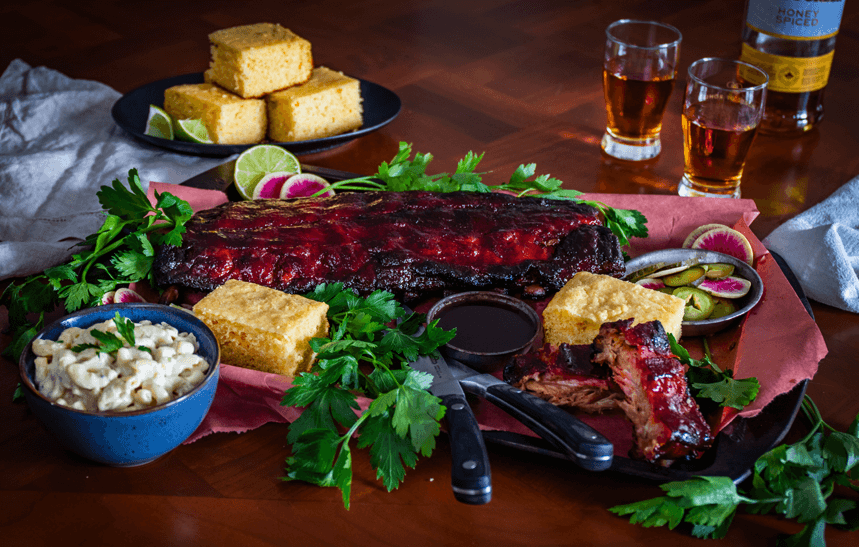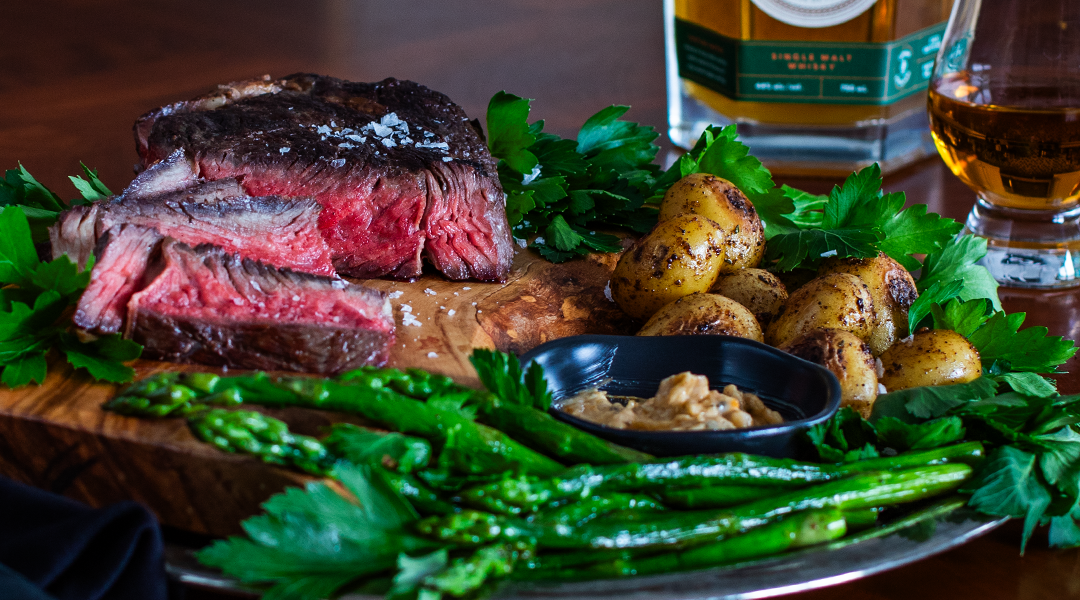We already know that cooking happens through radiation, conduction, or convection. We also know that the laws of thermodynamics state the coldness of the meat cannot flow into the heat of the cooker, instead, the heat from your BBQ excites the cold molecules making them hot. Finally, we know that the type of meat and the final results being sought after should have a direct impact on the cooking method being used. Here, we’re going to explore what happens to the muscle fibers at different temperatures and how the type of meat can determine cooking time.
COOKING METHODS
It’s been said before and will be said again. The cooking method should be dictated by the kind of meat you are cooking. The more the muscle was used in the animal, the harder it worked, and the longer and gentler the cooking method may need to be. That is because these muscles are filled to the brim with connective tissue and collagen that needs to be broken down. The closer the cut was located to the spine, the more likely that cut is to be tender.
High-heat cooking methods – taking place at temperatures of 325°F / 163°C or higher – like an infrared burner or direct cooking methods – on grids or in a pan – are ideal for foods that are small and fast cooking, and/or naturally tender. Steak, chicken breasts, and pork chops are great examples of thinner foods where a lower internal temperature (compared to brisket or ribs) provides more tender results, while a Maillard crust is formed on the outside. When high heat cooking, the liquid on the surface of the meat will boil off, leaving the proteins and seasonings exposed to direct heat. We still suggest patting meat dry before cooking to remove as much of the surface moisture as possible and aid in browning.
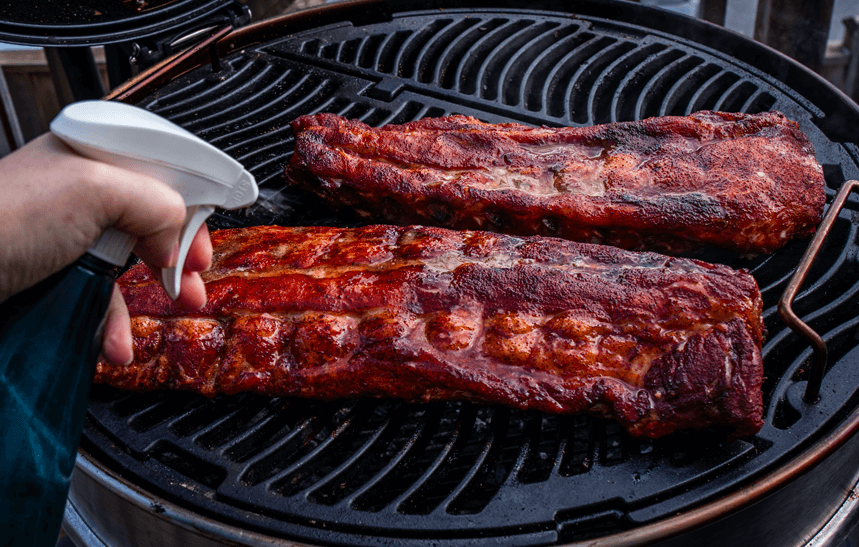
| Food | Safe Finished Temp | USDA Recommendation |
|---|---|---|
| Beef | Rare – 120°F (74°C) Medium-rare – 130°F to 135°F (54°C to 57°C) Medium – 140-145°F (60°C to 63°C) Medium-well – 150-155°F (66°C to 68°C) Well-done – 160°F (71°C) |
145°F (63°C) |
| Pork | 140°F (60°C) | 140°F (60°C) |
| Chicken (Poultry) | White Meat 155°F (68°C) for 60-sec Dark Meat 175°F (79°C) for 60-sec This provides a better texture due to connective tissues in the meat. |
165°F (74°C) |
| Seafood | Tuna (must be sashimi grade) – Rare – 115°F (46°C) Salmon – Medium – 125°F (52°C) Shellfish – 140°F (60°C) Scallops – 130°F (54°C) Halibut – 130°F (54°C) |
145°F (63°C) |
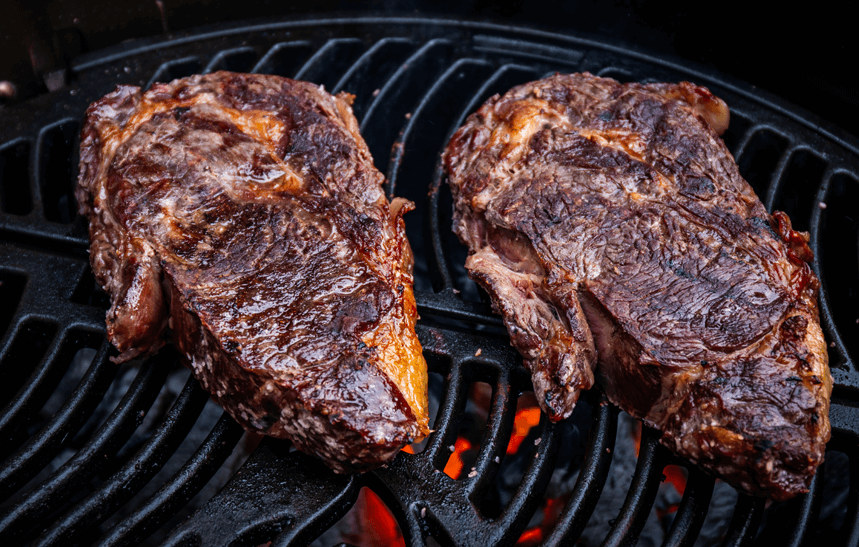
Thermodynamics states that the cold from your meat cannot pass into the hot surface being used to cook – no matter how much someone’s cold hands on your neck make you beg to differ. The heat from the cooking surface transfers into the meat, exciting the molecules along the way, creating a temperature gradient, the outside edges will be the hottest with the temperature dropping sharply for every millimeter closer to the center of the meat. This is why larger cuts of meat take longer to cook, you need to give the heat time to penetrate to the center of the cut of meat. When you take the meat off the heat, the warmth from the surface will continue to flow inwards, this is known as carryover cooking.
HOW TO USE AN INSTANT READ MEAT THERMOMETER
- Insert the probe well past the center of the food you are temp checking.
- Pull the probe back slowly. When the readout gives you the lowest temperature – which should be near the center of the meat – that is your current internal temp.
- Pull the meat if it is within a few degrees of the perfect finished temperature. From there, carryover cooking will finish the job as the food rests under a cloche or tented foil.
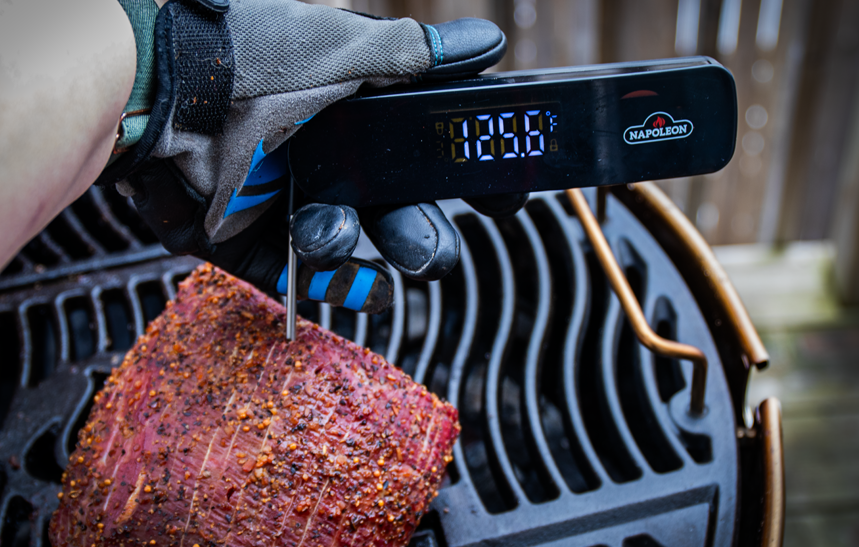
HOW LONG DOES IT TAKE TO COOK?
Time and temperature combine to render meat safe to eat and a pleasing texture. What remains is to understand why it takes the amount of time it does to cook. These are just a few of the various factors that will change the amount of time that it takes to cook a meal.
THICKNESS & WEIGHT
Although weight is related to how long it will take to cook any given cut, it is actually the thickness that will determine how long meat takes to cook. This is because cooking time depends on how long it takes for the center of the meat to heat up to the desired temperature. The cooking process starts with heating the outside – on all sides – and then moves into the center.
Consider a larger cut like a pork loin roast or a beef tenderloin. Both are long-ish cylinders of meat. It will take the pork loin roast around the same amount of time to cook, whether it’s the whole roast or half a loin roast. This is because the distance from the outside of the largest surface area – any point on the circumference – to the center of a roast is the same distance. The only exception where cooking time will be less is when the roast is actually shorter than the thickness. This provides the heat a quicker path to the center of the meat, cooking it faster. But, if the roast is that short, then it would be closer to a thick cut rather than a roast.

A great example of this would be when I purchased a whole, 6 to 7 bones, prime rib of beef. It was over 2 feet long. It was a last-minute request that needed to be ready to go for early the following day. I planned to cook it low and slow, overnight. I set two probes to monitor the cook, expecting the beast to take at least 8 hours to cook. Less than 5 hours later, I was getting notifications that it was almost to temperature, and it needed to be pulled and rested.
DENSITY & MAKEUP
Meats with higher densities of connective tissues need to be cooked to higher internal temperatures than more tender cuts. For these connective tissues to break down enough to make these tough cuts enjoyable, they need to be exposed to heat for a longer period of time and cooked to a higher finished temperature. This is why you cook ribs to 205°F (96°C). This breaks down collagen and connective tissue to become gelatin. While the meat proteins are heated and shrinking, they are pushing water out, however, the gelatin absorbs that liquid to create a succulent final product.
Collagen needs temperatures of over 175°F (79°C) to break down and gelatinize.
TEMPERATURE & HUMIDITY
Naturally, the temperature of the cook has a direct impact on how long it takes for food to cook. It is highly suggested that you measure this with a thermometer at cooking level to ensure accurate temperature readings. A lid thermometer, while a fantastic tool, only indicates the average temperature within the BBQ. The outdoor temperature will impact the internal temperature of your barbecue as well. Wind, snow, rain, and hot sun can alter a barbecue’s internal temperature too.
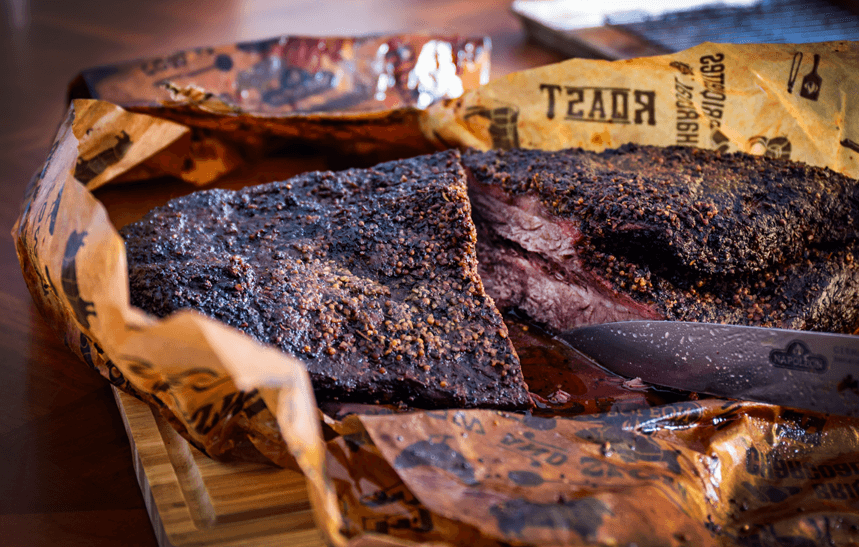
When discussing cooks that are considered low and slow, humidity can change cook times dramatically. The more humid it is, the more challenging it is for evaporation to happen. This can lead to a stall, where the heating rate of the meat and the temperature of the smoker matches that of the rate of evaporative cooling. Cool days are generally less humid; however, the temperature can impact how well your cooker heats and retains said heat, leading to increased fuel consumption. The opposite of this can also be true, a hot day with humidity can lead to massive stalls and increased internal BBQ temperatures.
WHAT HAPPENS TO MEAT WHEN YOU COOK IT
Understanding how the food you are cooking goes from raw to delicious can be a challenge. With the right equipment and planning, you can achieve some of the best food you have ever eaten. Time and temperature have denatured the protein and oxidized the meat, and it is now a safe internal temperature as well as desirable colour and texture. But what has happened as it moved through these temperature zones?
| Meat Temperature | What’s Happening |
|---|---|
| 105°F to 125°F (41°C to 52°C) |
Meat proteins and calcium proteins in the cut being cooked are denaturing, while the protein strands begin to unwind. Exterior colour of the meat changes. An aging effect rapidly happens, increasing flavours. |
| 125°F (52°C) |
Myosin denatures creating a white opacity in meat, which coagulates and scatters light, turning red meat to pink. Water and juices in the meat begin releasing. |
| 130°F to 140°F (54°C to 60°C) |
Meat goes from pink to grey-brown as myoglobin breaks down. Meat will begin to rapidly shrink due to the loss of juices. Cuts will go from medium-rare to medium-well swiftly, increasing the danger of overcooking. |
| 160°F (71°C) |
At these temperatures, connective tissue begins to liquefy. If using a hot and high cooking method, protein begins to repel water in earnest as it tightens quickly and shrinks. If cooking low and slow, this is where the magic, and tenderness, begin to happen. |
| 180°F to 205°F (82°C to 96°C) |
When cooking low and slow, the connective tissue and collagen melts and becomes gelatin which absorbs the meat’s juices. Protein is still pushing away water, directly into that gelatin, creating tender and succulent results. If using hot and high methods, you have likely created something akin to a hockey puck or shoe leather at this point. |
PEOPLE ALSO ASKED:
WHAT HAPPENS WHEN MEAT IS HEATED?
Meat goes through a few stages when heated, but its behavior depends on the type of heat applied. If you throw meat directly onto a very hot surface it will instantly contract. This squeezes out the liquid inside and can make some cuts chewy or unpalatable or have the benefit of creating a crust and sealing in the juices. If you gently heat meat using a different technique, the gentle heat has the benefit of melting connective tissue and collagen to create a succulent and juicy result.
HOW DOES MEAT CHANGE WHEN COOKING?
At 105°F to 125°F (41°C to 52°C), meat proteins denature, altering their colour and enhancing flavours. At 125°F (52°C), myosin denatures, creating a white opacity and releasing juices. Between 130°F and 140°F (54°C and 60°C), myoglobin breaks down, turning meat grey-brown and causing rapid shrinkage. At 160°F (71°C), connective tissue liquifies, leading to tenderness. Finally, at 180°F to 205°F (82°C to 96°C), collagen melts into gelatin, creating succulent results in low and slow cooking methods but risking toughness with high heat.
WHAT HAPPENS CHEMICALLY WHEN MEAT IS COOKED?
Several chemical reactions happen to meat when it is cooked. In high-heat scenarios, the outside of the meat will brown when the iron molecules oxidize in the Maillard Reaction. This is a tasty and desirable result and foods are finished at high temperatures after gentle cooking to achieve this. If you are smoking, instead of oxygen, carbon dioxide (CO2) and nitric oxide (NO) bond to the surface of the meat and create a pink ring just below the surface while the outside that is coated in a cocoon of seasoning polymerizes and hardens once the moisture from the melted fat on the surface of the meat has evaporated.
WHAT DOES MEAT RELEASE WHEN COOKED?
When it is cooked, the meat will shrink and release the liquid stored within the fibers. This includes water and fat that melts during the cooking process. Once cooked, and especially if you don’t rest the meat properly, a substance called myoglobin, a combination of water and liquid protein will leak out.
MAKE IT DELICIOUS
Understanding how the food you are cooking gets from raw to delicious can be a challenge, however, with the right equipment and planning, you can achieve some of the best food you have ever eaten. Now that you know what happens to meat as it cooks, do you think it will change the way you cook? How will you apply this knowledge? Share your barbecue and barbecued triumphs, your stories, recipes, and photos with us on social like our Facebook and Tiktok pages using the hashtags #NapoleonEats and #NapoleonBBQs.
